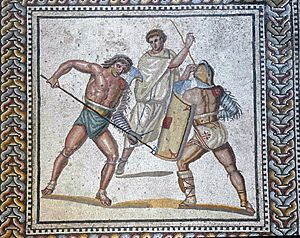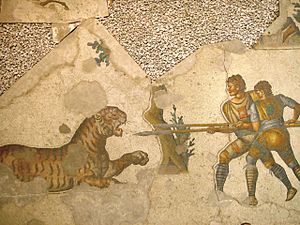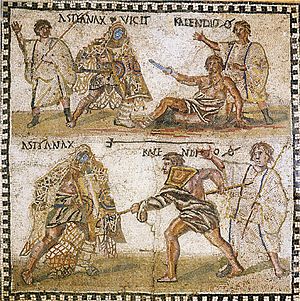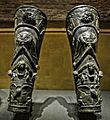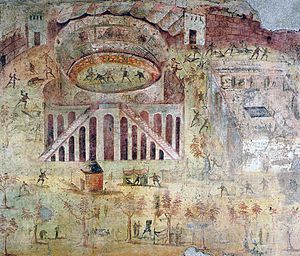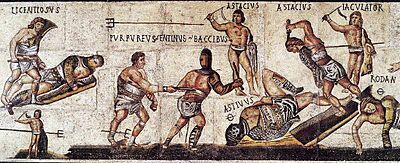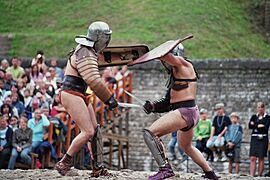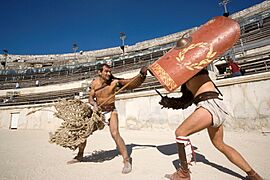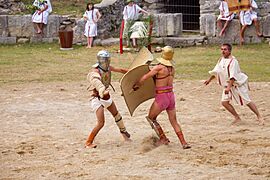Gladiator facts for kids
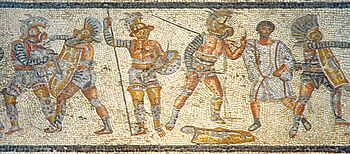
A gladiator (Latin for "swordsman," from the word gladius, meaning "sword") was a special kind of fighter in ancient Rome. These armed warriors entertained large crowds in the Roman Republic and Roman Empire. They fought against other gladiators, wild animals, and sometimes criminals as a form of public punishment.
Some gladiators were volunteers who chose to risk their lives in the arena. However, most were slaves or prisoners of war who were forced to fight. They were trained in harsh schools and were often looked down upon in Roman society.
No matter where they came from, gladiators were seen as symbols of Rome's fighting spirit. By fighting bravely, they could win fame and the admiration of the public. Gladiators were so popular that they were celebrated in art, from fancy mosaics to simple decorations on everyday objects. The gladiator games were a major part of Roman culture for almost a thousand years.
Contents
History
Origins

No one is completely sure how gladiator fights began. The first clear records of gladiator combat come from the 3rd century BC, during a time of war for Rome. These early fights were part of funeral ceremonies for important people. They were called a munus, which means a "duty" or "gift" to honor the spirit of someone who had died.
The historian Livy wrote that the first Roman gladiator games were held in 264 BC. A man named Decimus Junius Brutus Scaeva had three pairs of gladiators fight to the death to honor his father.
These early games were heavily influenced by Rome's enemies, especially the Samnites. The Romans admired the Samnites' weapons and armor. The "Samnite" became one of the first and most popular types of gladiator.
Growth of the Games
Over time, the games became bigger and more popular. What started as a private funeral rite turned into a huge public spectacle. By 105 BC, the government itself began to sponsor gladiator fights as a way to entertain the people and even train soldiers.
The games became an important part of Roman politics. Powerful Romans, called editors, would host gladiator games to become more popular with the public and win votes. A famous example is Julius Caesar. In 65 BC, he held a massive game with 320 pairs of gladiators in silver armor to honor his father, who had died 20 years earlier.
When the Roman Republic became the Roman Empire, the emperors took control of the games. The biggest and most amazing games were now linked to the emperor. This was a way to show the emperor's power and generosity. In 109 AD, the emperor Trajan held a 123-day festival to celebrate his military victories. It featured 10,000 gladiators and 11,000 animals.
Decline of the Games
The gladiator games began to decline during the Crisis of the 3rd century. The Roman Empire faced many problems, and the expensive games became harder to afford.
The rise of Christianity also played a big role in the end of the games. Christian writers and leaders spoke out against the violence of the arena. In 325 AD, Emperor Constantine the Great, the first Christian emperor, made a rule against forcing criminals to fight as gladiators.
In 393 AD, Emperor Theodosius I made Christianity the official religion of the empire and banned many pagan festivals. The gladiator games were officially ended in the Western Roman Empire by Emperor Honorius around 404 AD. However, animal hunts, called venationes, continued for about another century.
The Gladiators
There were many different types of gladiators, each with unique weapons, armor, and fighting styles. Early types were named after Rome's enemies, like the Samnite, the Thracian, and the Gaul.
Later, new and exciting types were introduced. Fights were often set up between gladiators with different advantages and disadvantages. For example, the lightly-armored retiarius used a net and trident. He was often matched against the heavily-armored secutor, who carried a large shield and sword. This made the fights more interesting to watch.
Gladiators came from different backgrounds. Many were prisoners of war or slaves who were being punished for crimes. The strongest of these were sent to gladiator schools for training. Others were free men who volunteered to become gladiators. These volunteers, called auctorati, gave up their freedom for a chance to win money and fame. For a poor person, becoming a gladiator offered regular food, housing, and a path to fortune.
Female Gladiators
Female gladiators, sometimes called gladiatrices, were very rare and were seen as an exotic form of entertainment. They first appeared around 60 AD. Emperor Nero had women, men, and children from Ethiopia fight in a show to impress a visiting king.
A stone carving from Halicarnassus shows two female fighters named "Amazon" and "Achillia." The carving says their match ended in a draw, meaning they were both spared. Because they were so unusual, female gladiators were seen by some Romans as a sign of strange or improper entertainment. In 200 AD, Emperor Septimius Severus banned women from fighting as gladiators.
Emperors as Gladiators
Several Roman emperors, including Caligula, Titus, and Hadrian, were said to have fought in the arena. However, these fights were usually private, and there was little real danger to the emperor.
The emperor Commodus was a huge fan of the games and often took part himself. He would fight in the Colosseum as a gladiator, though his fights were usually staged so that he would always win. He was said to have fought with a wooden sword against other gladiators. He also boasted of killing 100 lions in a single day, most likely from a safe platform above the arena. His actions were not popular with the Roman elite, who thought it was undignified for an emperor to perform in the arena.
A Day at the Games
Gladiator games were big events that were advertised well in advance. On the day of the games, the events began with a grand procession called the pompa. The editor (the person sponsoring the games) entered the arena, followed by musicians and the gladiators themselves.
The Parade and Morning Events
The morning was usually filled with animal shows. Wild beast hunts, called venationes, were very popular. Special fighters called venatores or bestiarii would hunt and fight exotic animals like lions, tigers, and bears.
Around midday, public punishments would take place. Criminals were sent into the arena to be killed by wild animals or to fight each other with little chance of survival. These events were meant to show the power of Roman justice.
The Main Event: Combat
The gladiator fights were the main event of the afternoon. Before the fights began, the weapons were checked to make sure they were real. The crowd's favorite matches were between skilled gladiators with different fighting styles.
A referee, called a summa rudis, watched over the fight with an assistant. They carried long staffs and could pause the fight to give the gladiators a rest. Music was played during the fights, getting louder and more exciting at key moments to build suspense. Most fights lasted between 10 and 20 minutes.
-
A Murmillo gladiator helmet from Herculaneum
-
A shin guard showing the goddess Venus
Victory and Defeat
A gladiator won a match by defeating his opponent. The winner received a palm branch and a cash prize. A gladiator who lost could appeal for mercy by raising a finger. The editor of the games made the final decision, but he usually listened to the crowd's reaction.
If the crowd wanted the loser to be spared, they might cheer or wave cloths. This was called missio (meaning "release"). If the crowd wanted the loser to die, they would gesture with their thumbs. This gesture was called pollice verso ("with a turned thumb"), but we don't know for sure if the thumb pointed up or down.
A gladiator who was spared could fight another day. A gladiator who fought well over many years could win his freedom. This was symbolized by a wooden training sword called a rudis. One famous gladiator named Flamma was awarded the rudis four times but chose to continue fighting.
Life of a Gladiator
Schools and Training
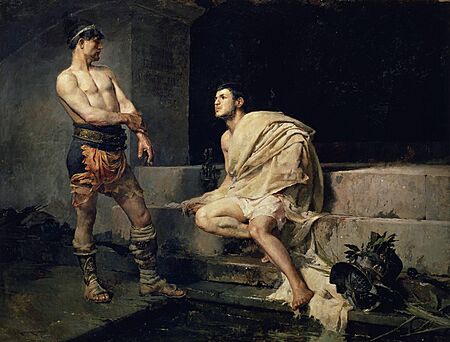
Gladiators were trained in special schools called a ludus. The owner of the school was called a lanista. He ran the school and his group of gladiators, which was called a familia gladiatoria.
Life in a gladiator school was very strict. Novice gladiators trained for hours every day, learning how to use their weapons and fight in a particular style. They used blunt wooden weapons for practice. They were also taught to face death without fear.
Despite the harsh discipline, gladiators were a valuable investment. They were given good medical care and were well-fed. Their diet was mostly vegetarian, consisting of barley, beans, and fruit. Because of their diet, they were sometimes called hordearii, which means "barley-eaters."
Social Status
Even though famous gladiators were celebrated like modern sports stars, they were at the very bottom of Roman society. They were considered infames, a term for outcasts who had few legal rights. They could not vote, hold public office, or even make a will.
This applied to all gladiators, including volunteers who had once been free citizens. By taking an oath to fight in the arena, they gave up their rights and submitted to the will of their master. Their lives were a strange mix of fame and dishonor.
Amphitheatres: The Arenas of Combat
The first gladiator fights were held in open spaces like the Roman Forum. As the games grew, the Romans began to build special venues for them called amphitheatres. These were large, oval-shaped buildings with seating that rose in tiers around a central arena.
The earliest known Roman amphitheatre was built in Pompeii around 70 BC. The most famous amphitheatre is the Colosseum in Rome. It was started by Emperor Vespasian and opened in 80 AD by his son, Emperor Titus. It could hold up to 50,000 spectators.
Seating in the amphitheatre was arranged by social class. The emperor and senators had the best seats near the front. The poor and women had to sit in the upper tiers, farthest from the action.
Factions and Rivals
Just like modern sports fans, Romans would cheer for their favorite gladiators and fighting styles. These fan groups were called factions. The two main factions were the scutarii, who supported heavily-armored gladiators, and the parmularii, who supported those with light armor.
Sometimes, the rivalry between factions and cities could become violent. In 59 AD, a riot broke out at the amphitheatre in Pompeii between the local fans and visitors from the nearby town of Nuceria. The fight became so serious that the emperor banned gladiator games in Pompeii for ten years.
Gladiators in Roman Culture
Gladiators were everywhere in Roman culture. They were like the superstars of their day. Images of gladiators could be found on mosaics, wall paintings, pottery, and even oil lamps. These items show us what the gladiators looked like, what kind of armor they wore, and how they fought.
Graffiti found on the walls of Pompeii shows how popular they were. One piece of graffiti calls a Thracian gladiator named Celadus "the sigh of the girls" and "the glory of the girls." This shows that gladiators, despite their low social status, could be admired and famous throughout the Roman world.
Modern Reconstructions
Today, some historical reenactment groups work to recreate Roman gladiator fights. They study historical sources to make their armor, weapons, and fighting techniques as accurate as possible. These groups perform at museums and historical festivals, giving people a chance to see what a gladiator show might have been like.
Images for kids
See also
 In Spanish: Gladiador para niños
In Spanish: Gladiador para niños


